By Thom S. Rainer
I would have never expected the response to a topic that seemed so innocuous. On this blog many people were very vocal that they really didn’t like the stand-and-greet time during the worship services.
To be fair, there were some defenders of this practice. I was able to segment the hundreds of responses into three groups.
- Guests: Overwhelmingly, guests do not like stand-and-greet. Very few indicated they did.
- Church members who are strong extroverts. This group tended to be the vocal supporters of stand-and-greet. They really like speaking to both strangers and acquaintances.
- The rest of the church members. The majority of the church members did not like the practice. It is the time of the worship service they dread.
So almost all of the guests do not like the stand-and-greet time, and the majority of the church members agree with them. As a consequence, many churches have dispensed with this practice.
But church leaders are finding other ways to keep their congregations friendly during the worship services. In this follow-up post, I share some of the new practices I have discovered.
- Conclude the services on time. The most natural time of fellowship takes place at the conclusion of each service. But, if the service goes long, many attendees are in a hurry to get their children from the preschool area, or to make previously scheduled appointments.
- Use the most outgoing members in critical places. One church has a highly extroverted senior adult lady as the receptionist to the preschool areas. Her sole, but critical role, is to greet parents and children, and to provide them a clear guide of where to go and what to do.
- Ask your most extroverted members to sit by guests and converse with them. Most of those who defended the stand-and-greet time where these extroverted members. Use them in other ways. And if the persons they find happen not to be guests, it’s not the end of the world. It’s okay for members to talk to one another.
- Ask your most extroverted members to mingle intentionally before and after the service. There is certainly a pattern developing here. The extroverted members want to act extroverted. Give them permission to do so. A few churches are even offering training for these extroverts.
- Have clear signage that lets guest know where to go. One church had the following signage at key entry points: “Guests: Follow the signs to our coffee gathering or to take your children to our safe and secure area.”
- Encourage people to speak to each other at the end of the service. If the service ends on time, encourage people to chat on the way out. Those who desire this interaction will do so. The rest will have permission not to do so.
- Have people wear shirts or badges that clearly indicate they are available to help others. I recently attended an event where people who could provide help wore brightly-colored shirts and well-marked badges. A church of which I’m aware does the same. The badge says in clear and bold letters: “I Would Love to Help You.”
Ultimately, friendliness is more of an attitude and atmosphere than a planned action. Leaders should provide such examples and continuously remind members to be hospitable and friendly at all times.
The meet-and-greet time is going away in many churches. These are some of the practices that are taking its place. Let me hear from you on this issue.
This article was originally posted on ThomRainer.com.
Thom S. Rainer is the president and CEO of LifeWay Christian Resources.






